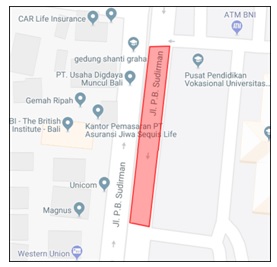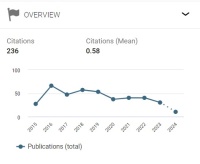Sistem Pelaporan Parkir Liar Berbasis Geolocation di Kota Denpasar
Abstract
Every year, the number of vehicles is increasing due to the development of the population, economy and improvement in living standard. Although there are parking lots, there are still many drivers who park their vehiclesin places where they can disrupt the smooth flow of traffic. The application of a parking reporting system uses the Google Maps API to mark areas and get coordinates for reporting illegal parking. The process of marking the parking ban area uses the polygon method with the number of roads as test data as many as 14 street names, 25 parking ban areas and 100 coordinate points (latitude, longitude). Every report on illegal parking has images and coordinates of location reporting that will automatically be validated by the system. The validation process by the system uses the JavaScript API Geometry library to get the results of whether a reported vehicle is in the parking ban area. Of the 12 coordinate points randomly placed with 6 positions insidethe parking ban area and 6 outside the parking ban area, the system is ableto validate the data correctly.
Downloads
References
[2] Anonim, “Pengembangan Kota Cerdas di Indonesia,” in Konferensi e-Indonesia Initiative (eII) dan Smart Indonesia Initiatives (SII) Forum ke-1, 2015.
[3] N. Ya’acob, A. M. Azize, and N. M. R. N. Z. Alam, “Parking System using Geographic Information System ( GIS ),” in IEEE Conference on Systems, Process and Control (ICSPC 2016), 2016, no. December, pp. 12–16.
[4] M. Al Mujabuddawat, “Geographic Information System(GIS) in Research and Presentation of Information Archaelogy,” Kapata Arkeol., vol. 12, no. 1, pp. 29–42, 2016.
[5] L. Gulick and L. Urwick, Papers On the Science of Administration, vol. 4, no. 3. 1937.
[6] N. Azizah and D. Mahendra, “Geolocation dengan Metode Djikstra untuk Menentukan Jalur Terpendek Lokasi Peribadatan,” J. Sist. Inf. Bisnis, vol. 02, pp. 96–103, 2017.
[7] M. Sharma and S. Morwal, “Location Tracking using Google Geolocation API,” Int. J. Sci. Technol. Eng., vol. 1, no. 11, pp. 29–32, 2015.
[8] M. Tahri, M. Hakdaoui, and M. Maanan, “The evaluation of solar farm locations applying Geographic Information System and Multi-Criteria Decision-Making methods: Case study in southern Morocco,” Renew. Sustain. Energy Rev., vol. 51, pp. 1354–1362, 2015.


This work is licensed under a Creative Commons Attribution-NonCommercial-NoDerivatives 4.0 International License.

This work is licensed under a Creative Commons Attribution 4.0 International License




